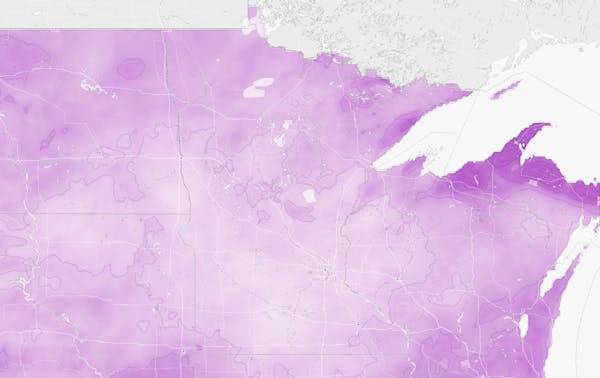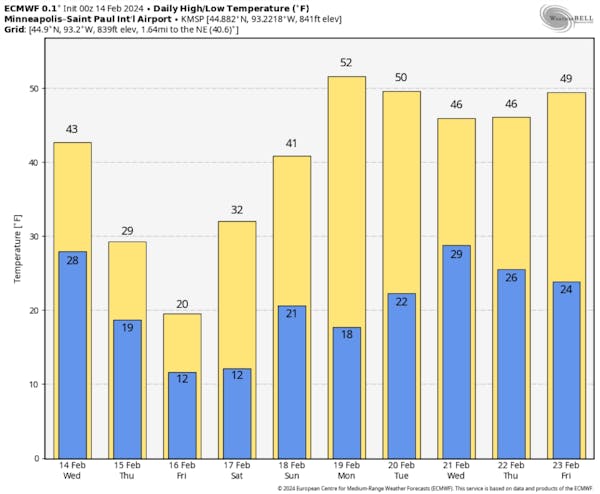The longest January thaw recorded in Twin Cities weather history is about to come to an end — with what's expected to be the largest snowfall of the season followed by the coldest day in more than three weeks.
A fast-moving front is forecast to bring 2 to 5 inches of snow across much of southern Minnesota and the Twin Cities, where a winter weather advisory is in effect through Thursday morning.
Snow started falling in Minneapolis around 3 p.m. Other cities in the advisory include Willmar, Redwood Falls, Mankato, Faribault and Rochester. Forecasts on Wednesday evening were showing that areas north of the Twin Cities — including Stearns, Isanti and Chisago counties — could see bigger amounts of snow.
An inch of snow was recorded at Minneapolis-St. Paul International Airport as of 6 p.m. Wednesday, and the National Weather Service office in Chanhassen had received 1.2 inches. Totals by early Wednesday evening were higher in St. Cloud and Stearns County, with reports of 5 to 6 inches of snow at around 7 p.m., according to National Weather Service meteorologist Caleb Grunzke.
Some places under the advisory were expected to receive 6 inches of snow or more as the storm passes through, said Melissa Dye, a meteorologist with the National Weather Service.
"It's tricky to nail that down," she said. "We won't know where until right before it happens."
What is a sure bet is that thousands of Minnesotans will be pushing shovels or cranking up snow blowers for perhaps the first time this season to clear away the wet, heavy snow.
The State Patrol reported 125 crashes statewide from noon to 9 p.m. Wednesday, resulting in 10 injuries and 74 spinouts. "If you are driving, keep it slow," Dye said; if shoveling, she added, "Take it easy." Grunzke said the snow is a stickier kind that can create icy road conditions.
The Twin Cities has not had measurable snow in 25 days, and the Valentine's night storm could bring the largest snowfall of the season — more than the 2.7 inches the metro area picked up on Oct. 30-31, the Weather Service said.
Since then, the Twin Cities has had a paltry 7.3 inches of snow for the season, with the last measurable snow recorded on Jan. 19. Three days later the mercury rose above the freezing mark, and high temperatures in the metro area have gone over 32 degrees every day since.
The snow drought has made it tough for folks putting on this weekend's Cross-Country World Cup skiing events in Theodore Wirth Park in Minneapolis. More than 35,000 people are expected to attend races Saturday and Sunday.
"It was a Herculean effort" to get the 7-kilometer course ready and keep it fit for the 199 athletes competing, said Claire Wilson, executive director of the Loppet Foundation, which is putting on the event. But any snow that falls "will make it look like a winter wonderland," she said. "That would be the best gift ever."
The warm streak of 24 days has made for the longest January thaw in the metro in more than 180 years of weather recordkeeping. A January thaw is defined as two consecutive days of above freezing temperatures during the month, though it can start in December and run into February if two of the days are in the first month of the year, according to the State Climatology Office.
The old mark of 21 straight days was set from Dec. 19, 2006 to Jan. 8, 2007. St. Cloud had its longest January thaw on record this year, spanning 17 days from Jan. 24 to Feb. 9, the Climatology Office said.
Thursday and Friday are expected to bring temperatures more normal for the second week of February. Thursday's forecast high is around 30 degrees and Friday's — gasp! — is a bone-chilling 23.
But this week's snow and cold will be brief, and "not a signal for those who like colder weather," Dye said. Temperatures are expected to moderate back into the 30s by Sunday, and the Climate Prediction Center calls for warmer than average temperatures to hang around for the next two months.
The warm and snowless winter has already produced six record high temperatures in the Twin Cities, including 57 degrees on Feb. 6. Thermometers have recorded 12 days of high temperatures of 50 degrees or warmer in December, January and February, the three months defined as meteorological winter.
Records have tumbled in other cities statewide. International Falls, known as the "Nation's Ice Box," had never seen 50 degrees in January; this year it happened twice. Rochester and St. Cloud each have set six record high temperatures over the past three months, and February still has two more weeks to go.
Winters like this could become more common, said Peter Girard of the New Jersey-based Climate Central, which studies the impact of the changing climate. The nonprofit has created a Climate Shift Index to compare current conditions with historical norms dating to the 1970s and rates the likelihood of greenhouse gases elevating the temperature on any particular day.
"The Minneapolis area is dead center in this wide bubble on the map where clearly climate change is influencing temperatures," Girard said.
That's not to say cold and snowy winters, like last year's, aren't still in our future. But with cold snaps lasting an average 5 days shorter than 30 years ago in the Twin Cities and 236 other American urban areas, climate-influenced warming could bring more winters like this one, Girard said.
Prolonged warmth is a threat to fruit trees, which need long periods of dormancy to rest and produce good crops. The mild conditions could be detrimental to water sources dependent on snow melt and also could lead to a larger tick and mosquito population this summer, he said.
Staff writer Louis Krauss contributed to this story.
One day in the frantic life of a Children's Minnesota emergency room nurse
State Sen. Nicole Mitchell off committee assignments while case under review

GOP endorses Tad Jude for congressional seat Dean Phillips is leaving


